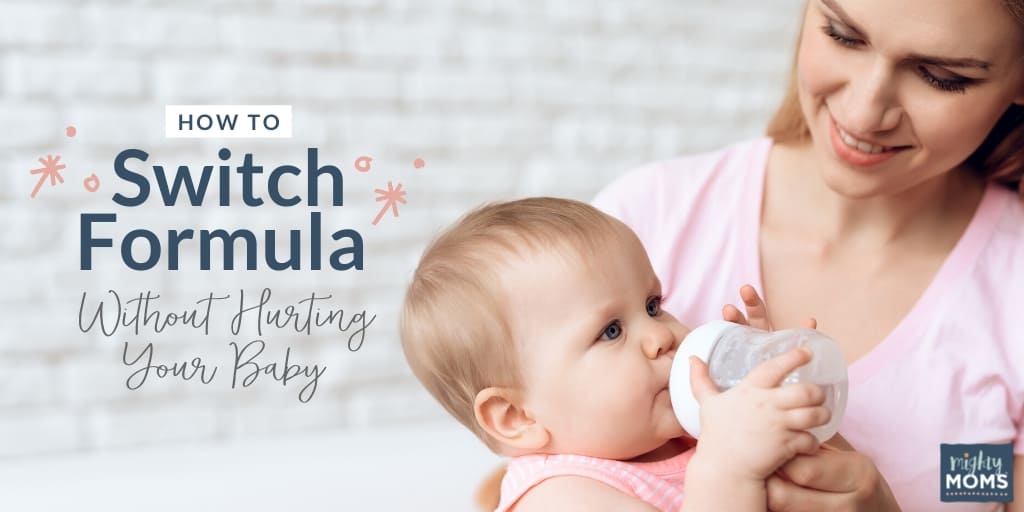
Perhaps one of the hardest things about giving formula is knowing whether you picked the right one. Is switching baby formula the right move? Or should you wait a few more days.
I, my friend, am here to help.
Here’s everything you need to know to switch formulas without messing with your baby’s sensitive digestive track.
Step One:
Determine the Formula Mob Family
A Formula Family is a group of formulas that are designed for a specific purpose or made with specific ingredients.
The first step to ensure your switching will go down like a boss is to determine the type of formula you’re using, and the type of formula you want to switch to.
If they are in the same family, you’re fine. Switch away. If they’re not…you’ve got a bit of work to do.
Here are the main “Formula Mob Families” you need to know.
Formula Mob Family #1: Bovine-Based
This formula family has the most members, because most of the standard baby formulas are based on cow’s milk (bovine = cow).
If your baby doesn’t have any health issues and is drinking formula, he’s most likely drinking a formula that is built around the cow’s milk dairy proteins.
So if you’re using Good Start and want to try switching to a baby formula like Similac, go for it. Watch your baby carefully for signs of fussiness the first day, but generally the transition is pretty easy.
Formula Mob Family #2: Goat-Based
In the past few years, there’s been a huge uptick in the number of parents turning to goat’s milk formula.
- It tastes sweeter, more like breastmilk.
- Goat’s milk makes a smaller curd in the stomach, so is much easier for small tummies to digest, lowering incidents of constipation and gas.
- Studies like this one have shown goat’s milk is a good choice for children who struggle with eczema.
If your baby struggles with these things and you want to give goat’s milk formula a try, click here to try a free sample. The formula is sold as a toddler formula, but is appropriate for any child over 6 months who is also eating solid foods.
For younger babies, or an organic goat milk option, try Holle Goat Milk formula. For more information about why parents are raving about European baby formulas, check out this article.
Formula Mob Family #3: Soy-Based
If your formula container says “soy” on it, you shouldn’t switch to another non-soy formula without going through the steps I’ve outlined below. I’ve listed the major brands of soy formula in my article What You Need to Know Before Giving Your Baby Soy Formula.
Formula Mob Family #4: Low-Lactose
The formulas in this family are all partially broken down, and are usually sold under the names “Sensitive” or “Gentle”. They are most commonly given to babies who are showing formula allergy symptoms.
Formula Mob Family #5: Hypoallergenic
These are the top-tier expensive formulas that are generally given to babies with severe allergies and colic.
They are completely lactose- free, and the proteins are so small that your baby only has to absorb them. There is almost no digesting at all. They are made so that ALL the proteins are already broken down.
Step Two:
Introduce the Families Slowly
The worst thing you can do for your baby’s tummy is to switch abruptly between the mobster formula families. They don’t take kindly to having other families take over their territory, and tummy rebellion is common.
To avoid these feuds, set up a schedule for switching baby formula on a gradual basis.
- First Day: 75% old formula, 25% new formula
- Second Day: 50% old formula, 50% new formula
- Third Day: 75% new formula, 25% old formula
- Fourth Day: 100% new formula
Of course, if you want to take two days (or more) for each step, that is totally up to you. Choose the speed that you think your baby would be most comfortable with.
Step Three:
Watch Your Baby’s Reaction
The best sign that you’re baby is switching baby formula effectively, is to watch your baby like a hawk in the first 24 hours.
Specifically, watch for these things:
- excessive gas (as in: more gas than normal)
- constipation (poop is thicker than peanut butter)
- diarrhea (watery, drippy poops)
- blood in the stool or in vomit (which would cause a good parent to call the doctor)
- hives or a rash (signs of an allergy)
- other signs of illness (limpness, clammy skin, etc.)
Any of these signs are indicators that you need to try a different brand, or switch to a different Formula Family, like goat’s milk.
Force the Mob to Get Along
Switching baby formula is really a lot easier than you may think. Just keep these things in mind:
- If you’re going to switch to a formula that is from a different “Formula Family” listed above, introduce the new one a little a time.
- Watch your baby closely during the transition to make sure no allergies are popping up.
- Talk to your doctor if you think a specialty formula (low-iron, hypoallergenic, lactose-free, etc.) may be required.
If your baby seems really fussy on his current formula, by all means try switching baby formula.
Give that a week or two to see how it’s affecting him, and then, if you need to, switch again. I mean it! Don’t switch to more than one formula in a single week! His little body needs at LEAST a full week to try out the formula before you can know for certain. Switching too many times, too fast can really mess a baby up.
Be. Patient.
And then keep trying (in weekly increments!) until you find the formula that is the best baby formula for your baby.
The more you try, the more you’ll know don’t work, and the closer you’ll be to the one formula that fits your baby.
We ♥ honesty! This post contains affiliate links that provide extra money for our mutual coffee habits addictions. Click here to learn more. As an Amazon Associate I earn from qualifying purchases.


